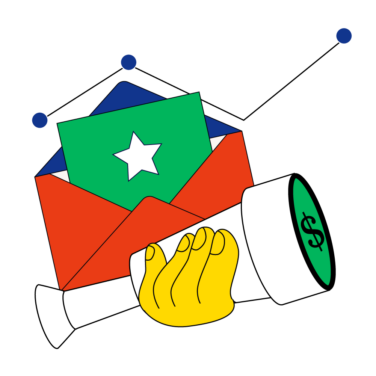Sales enablement is an important aspect of any business, but what is it exactly? And why is it so important?
Gartner describes sales enablement as “a critical function for helping sales teams navigate through the constant change that surrounds them—including the buying environment, the macroeconomic landscape and evolving seller roles.”
In its simplest form, sales enablement is the process of equipping sales teams with the knowledge and tools they need to sell more effectively.
But sales enablement is about so much more than just providing sales content and information. It's also about creating a culture of sales enablement within your organization, where everyone (especially the salespeople themselves) is invested in helping the sales function improve.
I’m Phil Gray, and I have over 10 years of experience in leadership and operations in industries that include biotechnology, healthcare, logistics, and SaaS. Now as the Chief Operations Officer at Black & White Zebra, my love for data and all things revenue operations has me here, sharing my acquired knowledge of sales enablement.
In this post, I’ll explain what sales enablement is and why it's important. I'll also provide actionable tips for creating a culture of sales enablement within your organization.
Understanding Sales Enablement: A Comprehensive Overview
Sales enablement is the process of equipping and training sales leaders to sell more effectively. It's all about arming your team with the right tools, resources, and knowledge they need to close more deals. This often takes the form of sales enablement content, which includes the following:
- High-value blog posts
- Product sell sheets
- Case studies
- White papers
- Sales playbook
- Explainer videos
- Sales presentations
- Proposals
- Webinars
- Testimonials
- eBooks
Sales enablement encompasses everything from training and education to process and technology. We’ll get into more about the tech and software side of things a little further into this article. For now, what’s important to note is that sales enablement is your fast path to increased sales efficiency and a better customer experience.
In a testimonial for sales enablement platform SalesHood, Jim Steele, President and CRO at Yext, explains: “We increased productivity 2.5X, increased cross/up-sell and new logos by 2X and drove up sales attainment 70% by getting teams aligned, on-message and learning from the best.”
Regardless of how you go about it, I’m sure you can find a similar level of success with sales enablement.
Sales Enablement vs Sales Training
This is a fair question, and one I get asked fairly frequently. Because where sales training exists, so must sales enablement, right? Well, yes…and no.
The line blurs a bit in between, but in essence, a proper sales enablement program focuses on discovering and testing new tactics and strategies, while sales training focuses on providing the actual instruction and hands-on exercises so reps can put them into practice.
Why Is Sales Enablement an Important Part of the Sales Process?
You might be wondering why sales enablement is so important. Here are some reasons:
1. It helps your sales team close more deals. When you give your sales reps the tools they need to be successful, they're going to be able to close more deals.
In fact, statistics show that organizations with sales enablement achieve a 49% win rate on forecasted deals, compared to 42.5% for those without.
2. It makes your sales process more efficient. The right tools and processes in place make it easier for your sales reps to do their jobs. And when things are running more efficiently, that means less time wasted and more money in the bank.
According to HubSpot, 50% of sales time is wasted on unproductive prospecting. And it’s shown that the best sales onboarding programs help new sales hires become productive 3.4 months sooner, on average. That's 37% faster than firms with low-performing programs!
3. It improves customer satisfaction. When your sales reps are able to provide the right solutions to customers' needs at the right point in the customer journey, that's going to lead to higher customer satisfaction rates. And happy customers mean more business for you in the long run.
In fact, it’s shown that 89% of consumers buy based on the overall sales experience regardless of price or functionality. And with 74% of buyers choosing the first company to add that value, you’re going to want to get it right—fast.
So as you can see, there are a lot of good reasons why sales enablement is so important. If you're not sure where to start, don't worry—we've got you covered. Keep reading for some best practices on how to get started with sales enablement today.
Best Practices for Your Sales Enablement Strategy
Sales enablement will look different from organization to organization, but here are some best practices to get you started:
- Make sure your sales reps have information in a format that's easy to digest.
- Train your sales team on how to use the tools they have at their disposal.
- Get buy-in from your salespeople to improve work on improving their skills.
- Set up regular check-ins with reps to see how they're doing and provide feedback.
- Give reps access to customer data so they can personalize their pitches.
- Encourage reps to use social media to build relationships with customers.
- Make sure that everyone is aware of what sales enablement is and what it entails. This includes the sales managers, the marketing department, and other stakeholders like the CEO.
- Establish clear roles and responsibilities for everyone involved in sales enablement. From content creation to closing deals, this will help ensure that everyone is rowing in the same direction.
- Create a process for measuring the effectiveness of sales enablement. This will help you track and improve your results over time.
Who Owns Sales Enablement?
Sales enablement comes under the remit of sales operations (Sales Ops) and revenue operations (RevOps). It involves using data to identify opportunities for improvement in the sales function. For example, perhaps a lot of deals are falling through at the last stage, in which closing would be something to focus on.
Another example is building out the processes to ensure that the sales team is kept up to date on the latest product developments and how to sell it to customers. This could come from the product marketing team, or whoever is in charge of content management for your business.
Related read: How Are Revenue Operations and Sales Operations Different?
Key Sales Enablement Tools and Software
Did you know that 55% of C-Suite executives say that sales enablement solutions are the top technology investment necessary to boost sales productivity? When it comes to sales enablement, there are a lot of different tools and strategies that can be used to directly help your entire sales organization close more deals. Here are some of the most important tools to consider:
Customer Relationship Management (CRM) Systems
One of the most important tools for sales enablement is a good CRM system. This can help you keep track of your pipeline and forecast more accurately (although there’s standalone sales forecasting software that you can integrate with your CRM as well). You should also make sure that you have a library of sales materials, such as product brochures, case studies, and white papers.
After a lot of in-depth research and testing, I put together a full list of the best CRM software. Here’s a sneak peek at a few options and their use cases:
- SAP CRM - Best for using customer data to personalize experiences
- Salesforce - Best customizable CRM
- Hubspot - Best for integrating with current systems
In a case study, Miele Professional used SAP Commerce Cloud and SAP Sales Cloud solutions to make B2B selling more intelligent and efficient. For them, being successful was all about speed, and their CRM system allowed them to close opportunities within 48 to 96 hours.
Proposal Management Software
Larger sales teams typically use some form of proposal management software to help them standardize the proposals and proposal process. This can help you to write, edit, send, and manage business proposals. Many organizations find it challenging to create proposal documents, which results in decreased numbers and lost sales—so these options exist to simplify the proposal writing process and increase revenue overall.
Again, here’s a sneak preview of a few tools I recommend:
- Proposify - Best for proposal design
- Better Proposals - Best for collaboration
- Qwilr - Best for web-based proposals
In a Better Proposals case study, Thor, a specialist recruitment agency, was wasting time creating documents in Microsoft Word, exporting them to PDF and emailing them out to clients one by one. With the right tech (Better Proposals, in this case) they were able to use templates to streamline their document processes. They had less errors, better visuals, faster sign-off and greater insights.
Sales Acceleration Software
Sales acceleration software can increase your sales process speed in an attempt to save time, effort, and money to increase efficiency. It’s important to remember that simplifying sales pipelines can run the risk of minimizing meaningful interactions with leads, so you want to do it correctly. We actually have another really interesting article on Speed to Lead, which you should check out for more on the topic.
A few of my recommended sales acceleration software options include:
- Salesforce Sales Cloud - Best all-in-one CRM for multiple departments
- Pipedrive - Best for automation
- Zendesk Sell - Best for sales engagement
In this case study, Zendesk Sell helped ClearCorrect, a leading manufacturer of clear orthodontic aligners, to build better relationships with their customers:
“We’ve been using Zendesk Sell for a year and a half. It is a great tool,” says Colin Crundall, ClearCorrect Account Manager. “For emails, you get notifications when people read the email– you know how effective your emails are. When I follow-up with people, I always know what the previous communications were…who I talked to and what we talked about.”
Communication Tools
And on that note of communication, don't forget about communication tools. These can help you keep your team connected and aligned on goals and objectives. Some popular communication tools include Slack, Asana, and Trello.
Another important aspect of sales enablement is training. You need to make sure that your reps are well-trained in both the product and the sales process. You can offer training in-person or online, depending on what works best for your team.
Tackling Industry-Specific Challenges with Sales Enablement
It’s worth noting that when it comes to sales enablement, different industries have their own unique set of hurdles, demanding a more tailored approach. For instance, the fast-paced tech sector demands agility and up-to-the-minute knowledge of evolving products and market trends. In contrast, the highly regulated pharmaceutical industry has to navigate really complex compliance issues.
Understanding these distinct needs is crucial for crafting effective sales enablement strategies that empower sales teams to exceed their targets, while remaining aligned with industry-specific regulations and customer expectations.
Overcoming Common Obstacles with Sales Enablement
For those in the SaaS industry, again these challenges are unique. Here are a few examples:
Problem: Enterprise SaaS solutions are complex, meaning the sales cycles are longer.
HubSpot found that the average length for a SaaS sales cycle is 84 days. Sales cycles with an annual contract value ACV below $5,000 can be shorter, around 40 days.
Solution: SaaS sales teams must spend more time and effort educating prospects throughout the buying process, answering questions, and ultimately delivering information. Ensuring you have sales enablement tools and content designed for each stage of the buyer journey can equip them for these scenarios. Contract management tools can also help keep your outstanding contracts organized and make it easier for large decision committees to redline.
Don't get burned! Learn the red flags that can void your contract.
Problem: Buying committees have multiple buyer personas.
According to Gartner, the typical buying group for a complex B2B solution involves six to 10 decision makers, each armed with four or five different pieces of information.
Solution: Design different pieces of sales enablement content for different ICPs. Consider who may be involved in decision making (the CEO, CFO, or other) and tailor white papers or case studies unique to the pain points and best interests of their role. According to Laire Digital, when salespeople deliver the right content to the right prospects at the right time, they generate 50% more sales-ready leads at 33% of the cost.
Problem: Qualifying leads for an enterprise SaaS product is also more complex.
Okay, so perhaps your lead isn’t the CEO or the CFO right off the bat. In this instance, a lot of time and money can be wasted encouraging website visitors to sign up for a free trial to demo the product.
Solution: Use sales enablement to train your sales reps on how to better screen leads. Try providing a self-guided questionnaire or placing some lead-qualifying roadblocks in the way so your reps can better protect their time. After all, Forbes reports that 57% percent of sales reps said their workload is more than their capacity.
More Articles
Sales Enablement Metrics to Note
In order to help you measure the success of your sales enablement initiatives, here are some important metrics you can track (and their respective formulas):
- Sales Cycle Length: Total number of days to close every sale / Total number of closed deals
- Win Rate: (Number of deals won / Total number of opportunities) x 100
- Time to Productivity: Days to train + Days to onboard + Days of shadow experience + Days of hands-on experience
- Rep engagement with content: (Total interactions with a piece of content / Number of content pieces) / Number of sales reps
- Content Effectiveness: (Number of closed deals influenced by content / Total number of deals) x 100
There are more, but this should really help get you going. Note that there are three main P’s of sales performance metrics: performance, proficiency, and productivity. You can see how each of the ones I listed above can easily fall into one of those three buckets.
Sales Enablement Resources
To find success with your sales enablement efforts, it's important to make sure that the resources are useful and relevant to your sales reps. They should be easy to use, and they should help reps overcome any objections or hurdles they might face while selling.
The resources should also be tailored to your company's unique selling process. Every business is different, and your reps will need different tools and resources depending on their industry and market.
Finally, the sales enablement team should be constantly updating and improving the resources based on feedback from the reps themselves. They need to be agile and responsive, so that they can quickly adapt to changes in the market and the needs of their customers.
Want more resources from us? Check out our articles on the different types of sales enablement content and how to increase revenue with a sales enablement strategy.
Conclusion
Sales enablement is a process that equips salespeople with the tools and resources they need to sell more effectively. It's important because it helps sales reps close more deals, which in turn helps the company grow.
There are many best practices associated with sales enablement, and it's typically owned by the marketing department. However, it's important to work closely with the sales team to ensure that the tools and resources provided are actually useful and relevant.
If you enjoyed this article or found it useful, let us know in the comments. Want to learn more about sales, marketing, customer success and all things revenue operations? Be sure to sign up for The RevOps Team newsletter.


